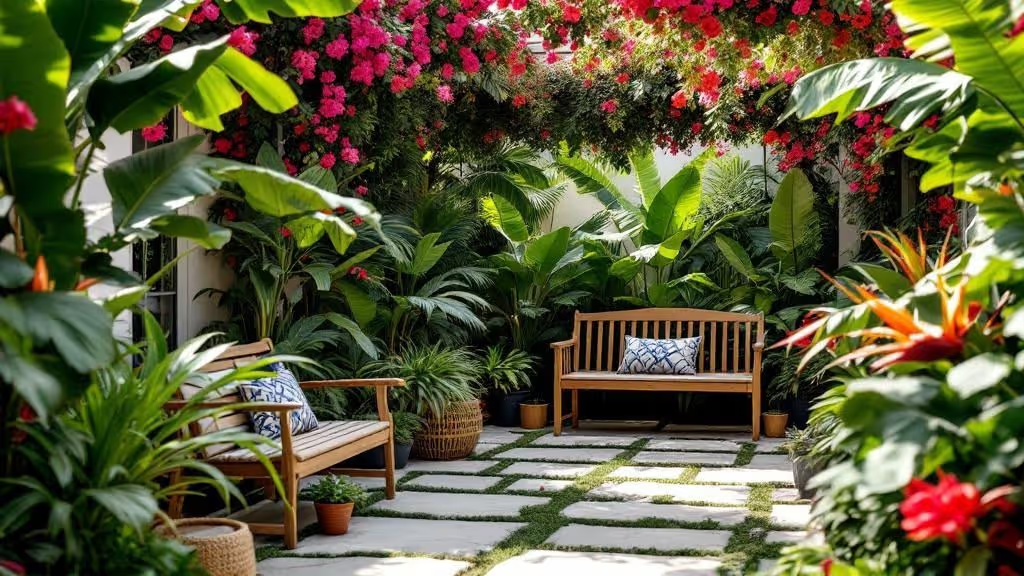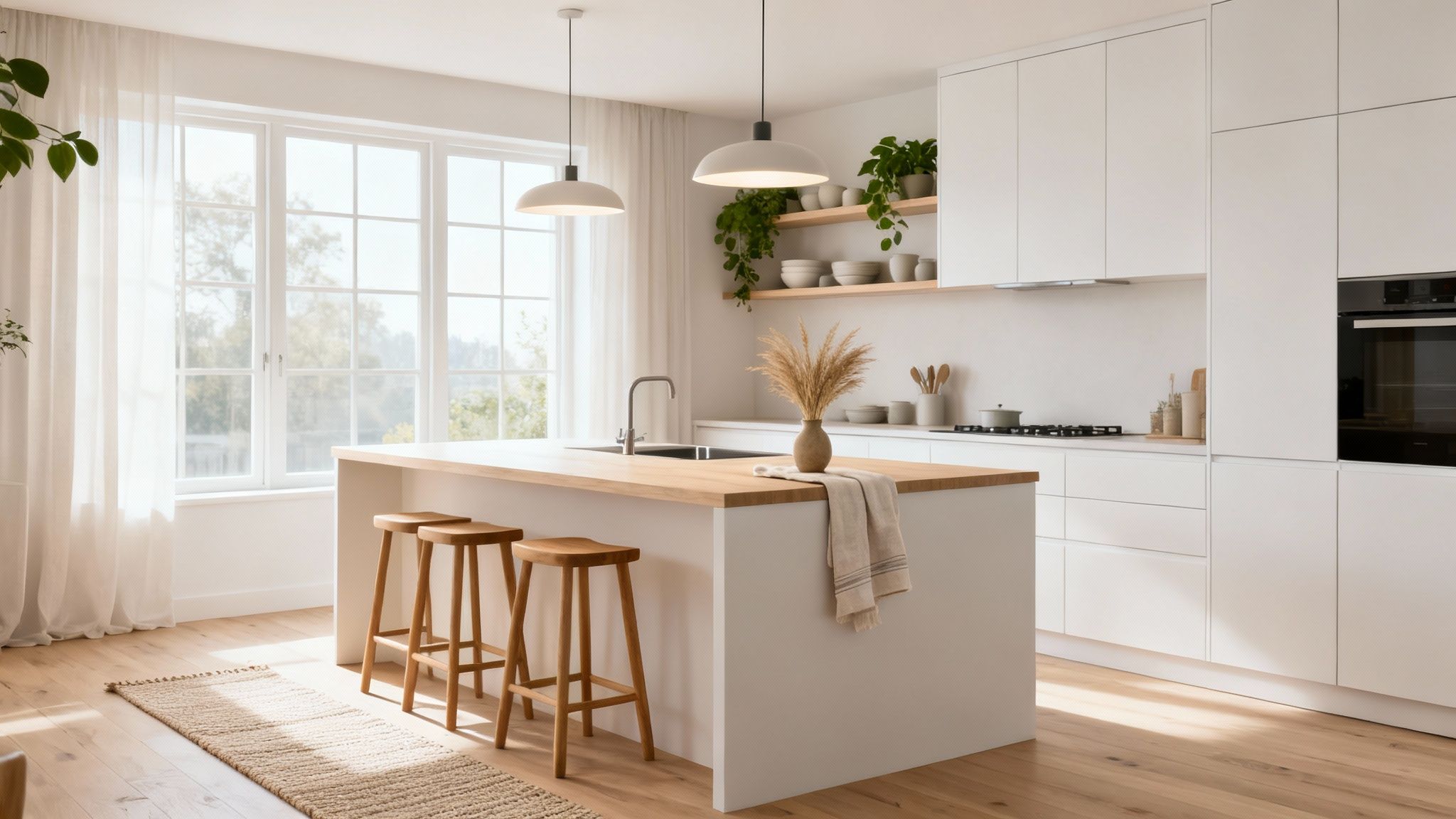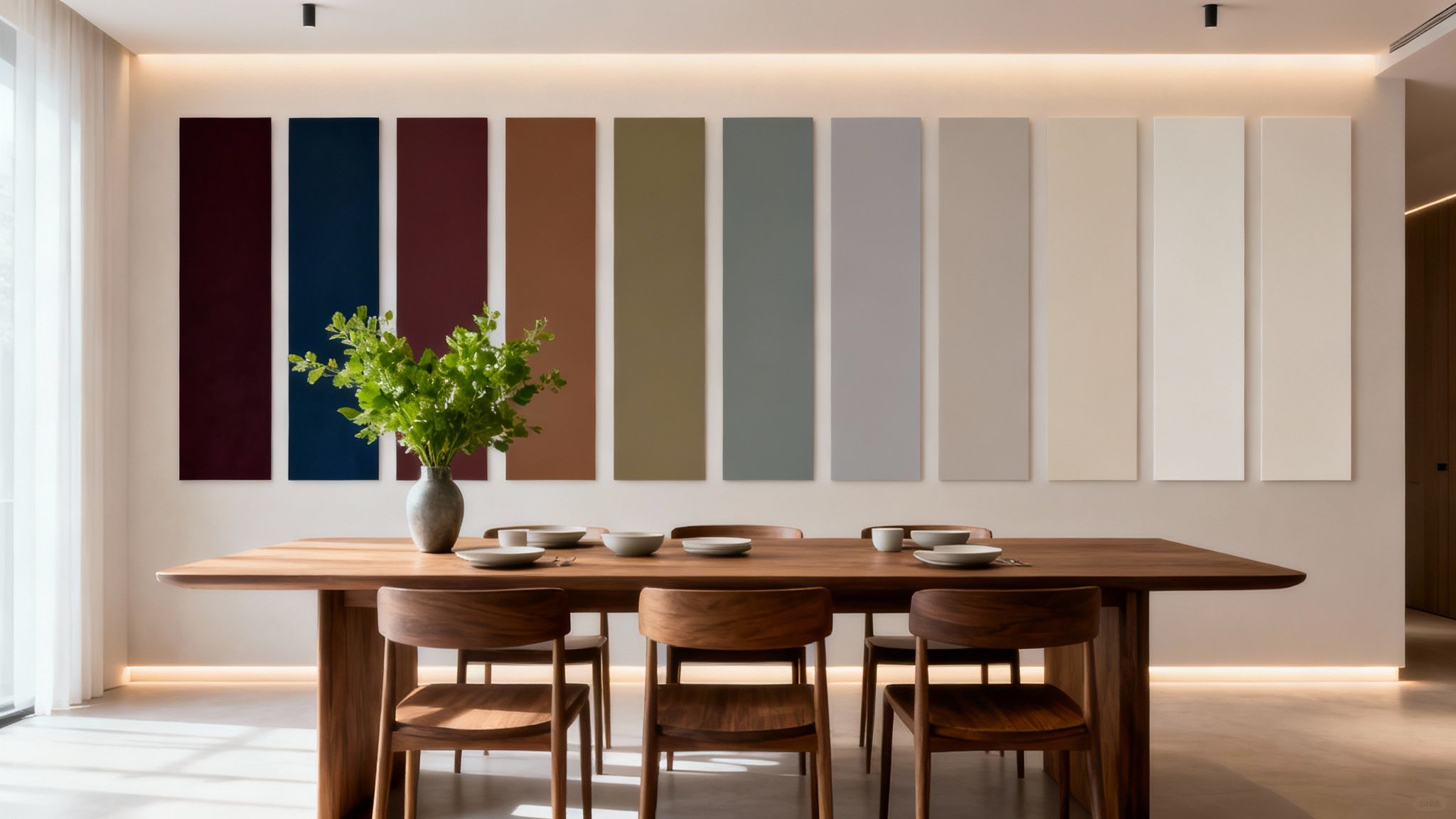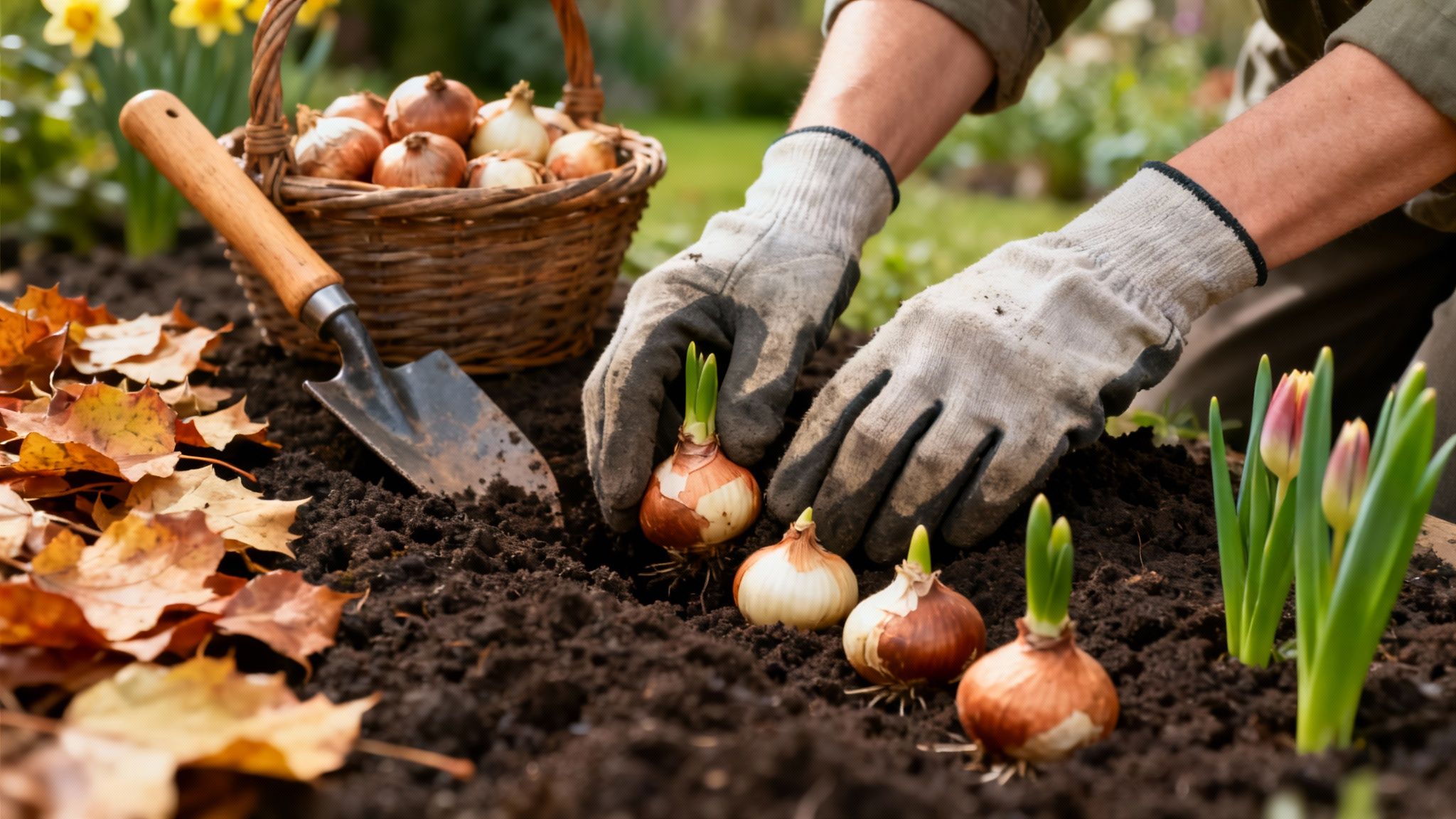Imagine stepping out your back door into a lush, vibrant sanctuary, a world away from the everyday. A tropical garden offers more than just plants; it's an immersive experience that engages the senses with bold foliage, exotic scents, and the gentle sound of rustling leaves. While the UK climate presents unique challenges, creating your own slice of paradise is more achievable than you might think. With clever plant selection, strategic design, and the right inspiration, you can cultivate a stunning retreat that feels both exotic and deeply personal. This guide moves beyond generic advice to provide a curated collection of actionable tropical garden ideas that work in a British setting.
We will explore practical concepts that empower you to transform your outdoor space, no matter its size. You will learn how to implement layered canopy designs for that authentic jungle feel, integrate mesmerising water features, and use bold, architectural foliage as a dramatic centrepiece. We'll also cover creating functional outdoor living spaces and harnessing vibrant colour palettes to mimic equatorial vibrancy. Whether you have a sprawling lawn or a compact urban courtyard, these concepts will equip you with the specific knowledge needed to bring a touch of the tropics home, creating a garden that is both a visual masterpiece and a personal escape.
1. Layered Canopy Design
One of the most authentic and impactful tropical garden ideas involves mimicking the natural structure of a rainforest through a layered canopy design. This approach goes beyond simply planting tropical species; it organises them into distinct vertical strata, from low-lying ground cover to towering emergent trees. The result is a dynamic, self-sustaining ecosystem that offers incredible depth, visual interest, and a genuine sense of jungle-like immersion. This method, popularised by landscape architects like Roberto Burle Marx, creates a multi-dimensional garden that feels lush and established.
The core principle is to replicate the four main layers of a forest: the emergent layer (tallest trees), the canopy (dense leafy treetops), the understory (shade-loving shrubs and small trees), and the forest floor (ferns, mosses, and ground cover). This creates microclimates within your garden, where shade from taller plants protects more delicate species below. For inspiration, look to world-renowned examples like the rainforest section of the Singapore Botanic Gardens or the Fairchild Tropical Botanic Garden in Miami.
How to Implement a Layered Canopy
Creating this effect requires forward planning, particularly concerning plant selection and placement.
- Start with the Canopy: Begin by planting your tallest, fastest-growing trees like Royal Palms (Roystonea regia) or a dramatic Silk Floss Tree (Ceiba speciosa) to establish the uppermost layer. Their height will eventually provide the necessary shade for the layers beneath.
- Plan for Maturity: Always research the mature size of each plant. A common mistake is planting too close together, leading to an overcrowded, unhealthy garden down the line. Give each plant the space it will eventually need to thrive.
- Layer Downwards: Plant the understory layer with shade-tolerant species like Tree Ferns (Dicksonia antarctica), Heliconias, and large-leafed philodendrons. Finally, fill in the forest floor with smaller ferns, Calatheas, and creeping ground covers to complete the lush, dense look.
- Infrastructure First: It is crucial to install any necessary irrigation systems before planting the upper layers to avoid disturbing root systems later on.
2. Water Feature Integration
A truly immersive tropical garden engages all the senses, and nothing achieves this quite like integrating a water feature. From serene ponds and babbling streams to dramatic waterfalls, water introduces the essential elements of sound, movement, and reflection. It serves as a natural focal point, enhances humidity for surrounding plants, and creates a tranquil atmosphere that instantly transports you to a lush, exotic paradise. Landscape designers like Anthony Paul and James van Sweden have long championed water features as a way to create dynamic, living art that complements and elevates tropical plantings.
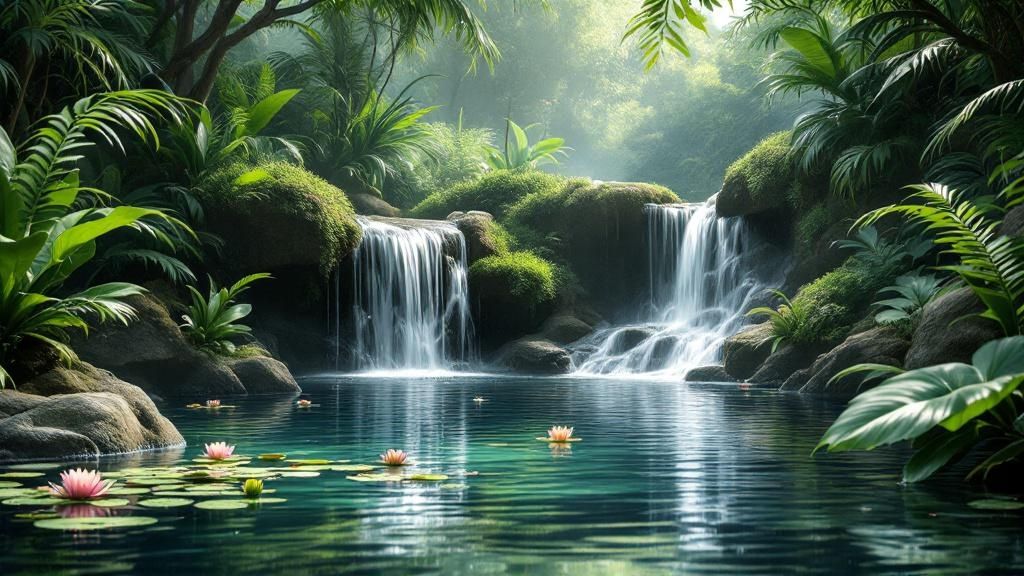
The core principle is to make the water look as if it naturally belongs in the landscape, rather than being an afterthought. This means using natural-looking materials and surrounding it with appropriate planting to soften the edges. Inspiration can be drawn from world-class examples, such as the jungle garden at The Huntington Library or the elaborate water gardens at Hotel Botánico in Tenerife, which masterfully blend water with dense foliage. These spaces use water to create a sense of calm and cooling relief, a key aspect of tropical garden ideas.
How to Implement a Water Feature
Successful integration requires careful planning of both the technical and aesthetic aspects to create a balanced and low-maintenance feature.
- Choose the Right Style: Decide if you want a still pond for reflection, a gentle stream for soothing sounds, or a cascading waterfall for dramatic effect. The style should complement the scale and mood of your garden.
- Plan for Practicality: Use efficient recirculating pumps to conserve water and install a UV steriliser to prevent algae build-up, ensuring clear water with less chemical intervention. Position your feature near a patio or seating area for maximum enjoyment.
- Encourage an Ecosystem: Introduce aquatic plants like Water Lilies (Nymphaeaceae) and Taro (Colocasia esculenta) to help oxygenate the water and provide natural filtration. Adding small native fish can also help control mosquito larvae.
- Blend with Plantings: Use lush, moisture-loving plants such as ferns, hostas, and Gunnera around the edges to seamlessly blend the water feature into the surrounding garden, making it feel organic and established.
3. Bold Foliage Focus
While tropical flowers are stunning, one of the most effective tropical garden ideas is to shift the focus to bold foliage. This design strategy prioritises plants with dramatic, oversized, or unusually shaped leaves to create a powerful visual impact through texture, size, and form. Instead of fleeting blooms, the garden’s structure and year-round appeal are built upon the architectural qualities of leaves, creating a tapestry of green hues and contrasting shapes. Landscape architects like Raymond Jungles and the late Made Wijaya masterfully used this technique to create lush, immersive green sanctuaries.

The core idea is to treat foliage as the main event. Think of the giant, sculptural leaves of a Giant Taro (Alocasia macrorrhizos) or the distinctive, perforated foliage of a Swiss Cheese Plant (Monstera deliciosa). This approach creates a deeply textural and sophisticated garden that feels primordial and calming. For inspiration, look to the incredible plant collections at the New York Botanical Garden's Haupt Conservatory or the cycad garden at Ganna Walska Lotusland, where ancient plant forms are the stars.
How to Implement a Bold Foliage Focus
Achieving this look is about deliberate composition and understanding how different leaf forms interact.
- Combine Different Shapes: Contrast is key. Place the broad, paddle-like leaves of a Bird of Paradise (Strelitzia nicolai) near the feathery fronds of a Kentia Palm (Howea forsteriana) to make each plant’s unique form stand out.
- Use Variegation for Accent: Incorporate plants with variegated leaves, such as the Stromanthe Triostar or a variegated Ginger, as accent pieces. Their splashes of white, cream, or pink will break up the sea of green and draw the eye.
- Group in Odd Numbers: For a more natural, less formal appearance, arrange plants in clusters of three, five, or seven. This is a classic design principle that creates a sense of harmony and balance.
- Mix Green Hues: A garden focused on foliage is far from monotonous. Layer different shades of green, from deep, glossy emerald to bright chartreuse and silvery-blue, to build incredible depth and visual complexity.
4. Outdoor Living Spaces
A truly immersive tropical garden blurs the line between indoors and outdoors, treating the garden not just as a view but as a functional extension of the home. This concept involves designing your lush planting around dedicated outdoor living spaces like dining areas, kitchens, and lounging zones. The goal is to create seamless transitions, where the garden becomes an open-air room enveloped in foliage, fragrance, and the sounds of nature. This approach, championed by landscape architects like Raymond Jungles, elevates the garden from a passive space to an active, integrated part of daily life.

The key is to create inviting "garden rooms" that feel both sheltered and connected to the wider landscape. This is one of the most practical tropical garden ideas for those who love to entertain or simply want a private escape. For inspiration, consider the elegant garden rooms of Doris Duke's Shangri-La in Hawaii or the resort gardens at The Ritz-Carlton Kapalua, which masterfully integrate leisure areas with stunning tropical flora. If you're looking for more inspiration, these garden entertaining ideas can help you plan the perfect setup.
How to Implement Outdoor Living Spaces
Integrating functional zones requires a blend of hardscaping, planting, and thoughtful amenities.
- Define the Zone: Use hardscaping elements like a wooden deck, a stone patio, or a gravelled area to clearly define the living space. A pergola or a large cantilevered parasol can create a sense of enclosure and provide essential shade.
- Plant for Purpose: Surround your seating areas with plants that enhance the experience. Use fragrant species like frangipani (Plumeria) or jasmine near lounging spots and plant natural mosquito-repellents like citronella grass (Cymbopogon nardus) nearby.
- Plan for Practicality: Ensure the area has proper drainage to prevent water pooling after rain. Choose high-quality, fade-resistant outdoor fabrics for furniture and incorporate discreet storage for cushions and accessories to protect them from the elements.
- Consider Day and Night Use: Integrate ambient lighting, such as uplighting on specimen plants or string lights under a pergola, to make the space usable and magical after sunset. This ensures your tropical oasis is enjoyable around the clock.
5. Vertical Garden Systems
When ground space is at a premium, one of the most innovative tropical garden ideas is to build upwards with a vertical garden system. This approach transforms bare walls, fences, and trellises into vibrant, living tapestries of tropical foliage. By growing plants vertically, you can introduce a lush, jungle-like atmosphere into even the smallest courtyards, balconies, or urban gardens, maximising planting area without sacrificing valuable floor space. Popularised by visionaries like French botanist Patrick Blanc, this technique turns previously overlooked surfaces into stunning horticultural features.
The concept involves creating a structure that holds a growing medium, often a lightweight, soilless mix, against a vertical plane. This allows plants, particularly those with shallow root systems like epiphytes (air plants), ferns, and bromeliads, to thrive. For inspiration, look to the breathtaking vertical gardens at Singapore's Changi Airport or the sophisticated integration of nature and architecture in projects by Stefano Boeri. This method is not just aesthetic; it can also improve air quality and provide insulation for buildings. To see how a blank wall can be transformed into a work of art, you can learn more about creating a garden wall feature.
How to Implement a Vertical Garden
Success with a vertical garden hinges on a well-designed system and careful plant selection.
- Choose the Right System: Options range from simple pocket planters and modular panels to sophisticated hydroponic felt systems. Your choice will depend on your budget, scale, and the types of plants you wish to grow.
- Install Drip Irrigation: Consistent moisture is critical, as vertical gardens dry out quickly. A built-in drip irrigation system with a timer is the most efficient way to deliver water and nutrients directly to the plant roots, ensuring even hydration.
- Select Appropriate Plants: Group plants with similar light and water requirements together. For a sunny wall, consider flowering vines like Mandevilla. For shadier spots, a mix of ferns (Nephrolepis), Pothos (Epipremnum aureum), and Philodendrons creates a classic tropical look.
- Ensure Proper Drainage: Good drainage is essential to prevent root rot. Make sure your system allows excess water to escape freely from the bottom, away from the wall's foundation. Using a lightweight, well-draining growing medium is also key.
6. Tropical Colour Themes
One of the most artistic tropical garden ideas is to design with specific colour palettes, moving beyond random plant placement to create a cohesive and emotionally resonant space. This approach uses both vibrant flowers and, crucially, colourful foliage to build a unified visual narrative. Whether you want a fiery, high-energy retreat or a cool, tranquil oasis, a deliberate colour theme can elevate your garden from a simple collection of plants to a thoughtfully curated experience. This method, championed by colour theory experts like Gertrude Jekyll and modernised for subtropical climates by designers like Debra Lee Baldwin, allows you to paint with plants.
The core principle involves selecting plants based on how their colours interact to evoke a particular mood. For example, the Butchart Gardens in Canada masterfully uses themed colour beds in its tropical sections to guide visitors through different atmospheres. Similarly, the Marie Selby Botanical Gardens often features exhibits organised by colour. This strategy is not unlike decorating a room; the same principles of harmony, contrast, and accent colours apply. You can learn more about how colours influence mood indoors and apply those lessons to your garden design.
How to Implement a Tropical Colour Theme
Achieving a sophisticated colour scheme requires careful selection and a focus on year-round interest.
- Foliage First: Use colourful foliage as the backbone of your theme. Plants like Crotons (Codiaeum variegatum), Caladiums, and Cordylines offer permanent colour that isn't dependent on fleeting blooms. This ensures your garden remains vibrant even when flowers are not in season.
- Succession Planting for Blooms: Plan for a succession of flowering plants to maintain your colour palette. As one plant's blooming season ends, another should begin. Combine early-blooming gingers with mid-summer hibiscus and late-season Tibouchina, for example.
- Use White as a Neutral: Weave in plants with white flowers or variegated white leaves, such as the Peace Lily (Spathiphyllum wallisii). White acts as a neutral element that breaks up intense colours, making them pop while preventing the overall design from feeling overwhelming.
- Consider Viewing Angles: Think about where you will be viewing the garden from. Place brighter, "hot" colours like reds and oranges further away to draw the eye, and use cooler blues and purples closer for a calming, intimate effect.
7. Sustainable Tropical Gardens
Designing a tropical garden with sustainability as a core principle creates a space that is not only beautiful but also ecologically responsible. This approach prioritises native plants, water conservation, organic practices, and habitat creation to build a resilient, low-impact oasis. By focusing on plants adapted to the local climate, you create a garden that thrives with less intervention, reducing the need for excessive watering, fertilisers, and pesticides. This method, championed by ecologists like Sally Wasowski, balances lush aesthetics with a profound respect for the natural environment.
The central idea is to create a garden that works in harmony with its surroundings rather than against them. This involves selecting species that naturally flourish in your specific conditions, thereby supporting local wildlife like pollinators and birds. Notable examples of this philosophy can be seen in the native plant gardens at the Fairchild Tropical Botanic Garden and the sustainable landscapes at the University of Hawaii, which showcase how regional flora can be used to create stunning, eco-friendly designs.
How to Implement a Sustainable Approach
Building a sustainable garden involves thoughtful planning and a shift towards nature-friendly practices.
- Prioritise Native Plants: Research and select plants native to your region. They are naturally adapted to the soil and rainfall patterns, requiring less maintenance and providing vital food and shelter for local fauna. Contact your local native plant society for recommendations.
- Conserve Water: Install rain barrels or a rainwater harvesting system to collect and store water for irrigation. Group plants with similar water needs together and use a thick layer of organic mulch to retain soil moisture and suppress weeds. Many sustainable techniques also result in a more low-maintenance garden, a concept you can explore further. Find out more about low-maintenance garden ideas on sprucecollective.co.uk.
- Create Your Own Compost: Set up a composting system to recycle garden trimmings and kitchen scraps into nutrient-rich soil amendment. This eliminates the need for chemical fertilisers and reduces household waste.
- Support Wildlife: Incorporate features that provide for wildlife, such as a small pond for insects and amphibians, plants that offer berries or nectar, and insect hotels. Consider using solar-powered lights or water features to minimise energy consumption.
8. Themed Garden Rooms
A highly sophisticated tropical garden idea involves dividing your space into distinct 'garden rooms'. This design approach creates a journey-like experience, guiding visitors through a series of unique environments, each with its own specific theme, function, or plant palette. Instead of one large, homogenous space, you get a collection of curated vignettes, adding intrigue, surprise, and a sense of discovery to your garden. This concept, championed by historic garden designers like Gertrude Jekyll, translates beautifully to a tropical setting, allowing for incredible diversity.
The core principle is to use hardscaping, clever planting, or structures to create defined zones. One room might be a tranquil Balinese water garden, another a vibrant and fragrant Plumeria collection, and a third a practical outdoor dining area surrounded by edible tropical fruits. This method allows you to experiment with different styles without creating a chaotic feel. For world-class inspiration, look to the specialised collections at the Huntington Library or the varied conservatory rooms at Longwood Gardens, which showcase this concept on a grand scale.
How to Implement Themed Garden Rooms
Thoughtful planning is essential to ensure a cohesive yet varied experience as you move through the garden.
- Establish Boundaries: Create clear, yet attractive, divisions between rooms. This can be achieved with low walls, bamboo screens, dense hedges of Hibiscus, or arched gateways covered in climbing Bougainvillea.
- Plan the Journey: Consider the flow from one space to the next. Use winding paths to build anticipation and vary the path materials, for example, moving from gravel in one room to stone slabs in another, to signal a transition.
- Use Transitional Plants: Bridge different themes by using 'connector' plants. A versatile palm or fern species placed on the boundary of two rooms can help create a smoother visual transition, preventing jarring changes in style.
- Incorporate Function: Design each room with a purpose. Include a secluded bench in a quiet foliage garden or a fire pit in an entertaining space. This makes each 'room' a destination in itself, enhancing the overall utility of your garden. You can explore more ideas for creating these intimate spaces by learning how to design a secret garden.
9. Microclimate Manipulation
One of the more advanced tropical garden ideas involves the deliberate manipulation of microclimates to cultivate a broader range of exotic plants. This technique moves beyond general planting and focuses on creating small, controlled environmental pockets with specific conditions. By strategically altering light, humidity, temperature, and wind exposure in different zones, you can successfully grow species that would otherwise not survive in your garden’s general climate, vastly expanding your botanical palette. This scientific approach, championed by horticulturists like Tony Avent and Dennis Schrader, allows for a truly diverse and specialised collection.
The core concept is to identify or create unique environmental niches within your garden. A south-facing wall can create a heat trap for sun-loving succulents, while a densely planted corner can provide the cool, humid shade needed for delicate ferns. For inspiration on a grand scale, consider the Missouri Botanical Garden's Climatron or the Eden Project's biomes, which showcase masterful climate control. These large-scale examples demonstrate how tailoring the environment is key to growing diverse tropical flora in a single location.
How to Implement Microclimate Manipulation
Creating these specialised zones requires observation and a few key tools and techniques.
- Create Light and Shade Zones: Use structures like pergolas, shade cloth, or dense plantings of taller species to create areas with different light intensities. This allows you to place high-light plants like hibiscus in full sun and shade-lovers like calatheas in protected spots.
- Manage Humidity: Install misting systems or group plants with high humidity needs together near a water feature. The collective transpiration will raise the ambient moisture, creating a perfect environment for epiphytes and understory species.
- Establish Windbreaks: A gusty corner can quickly dry out sensitive foliage. Plant a row of hardy, dense shrubs or install a trellis with climbing plants to create a calm, sheltered pocket for more delicate specimens.
- Use Thermal Mass: Incorporate large rocks, stone paving, or brick walls into your design. These materials absorb heat during the day and radiate it slowly at night, buffering against temperature drops and protecting tender plants from an unexpected chill.
Tropical Garden Ideas Comparison Table
Bringing Your Tropical Vision to Life
Creating your own verdant paradise is a deeply rewarding journey, transforming an ordinary outdoor space into a vibrant, life-enhancing retreat. We've explored a wealth of tropical garden ideas, moving from the structural elegance of a layered canopy design to the sensory delight of integrated water features. We've seen how a focus on bold foliage can create instant drama, how themed garden rooms can partition a space into distinct experiences, and how vertical gardens can maximise greenery in even the smallest courtyards. The beauty of these concepts lies in their flexibility; they are not rigid rules but a palette of possibilities waiting for your personal touch.
The journey from a simple patch of lawn to a lush oasis is built on a foundation of smart, strategic decisions. The most successful and sustainable tropical gardens are those born from a clear vision combined with a practical understanding of your unique environment.
Your Actionable Blueprint for a Tropical Oasis
To move from inspiration to implementation, consider these crucial next steps. This structured approach will help you organise your thoughts and bring your dream garden to life, one manageable stage at a time.
- Assess and Analyse: Before buying a single plant, take time to understand your garden's specific conditions. Map out sun-drenched spots and shady corners, test your soil's pH, and observe how water drains after rainfall. This initial analysis is the single most important step in preventing costly mistakes and ensuring your plants thrive. It's the blueprint upon which all successful tropical garden ideas are built.
- Prioritise Your Core Elements: You don’t need to implement every idea at once. Which concept resonates most with you? Is it the tranquil sound of a bubbling water feature, the architectural beauty of a covered outdoor living space, or the sheer visual impact of oversized leaves? Choose one or two central features to act as the anchors of your design and build outwards from there.
- Develop a Phased Planting Plan: A garden is an evolving entity, not a static installation. Begin with your "bones," the larger structural plants like hardy palms or bamboo that will define the canopy and structure. In the following season, you can introduce the mid-layer of shrubs and vibrant foliage plants. Finally, fill in the gaps with ground cover and seasonal pops of colour. This phased approach is more manageable for your budget and your schedule, and it allows the garden to mature naturally.
Cultivating More Than Just Plants
Embracing these concepts is about more than just horticulture; it's about crafting a lifestyle. A well-designed tropical garden extends your living space, offering a sanctuary for relaxation, a stunning backdrop for entertaining, and a daily connection to the natural world. It becomes a place to de-stress after a long day, to enjoy a morning coffee surrounded by birdsong, or to share a meal with loved ones under a canopy of lush leaves.
The key takeaway is that an extraordinary tropical garden is entirely within your reach. By combining creativity with careful planning and a patient, phased approach, you can cultivate a personal paradise that reflects your style and enhances your daily life. Let this be the start of your transformation, and enjoy every moment of watching your lush, tropical vision flourish.

